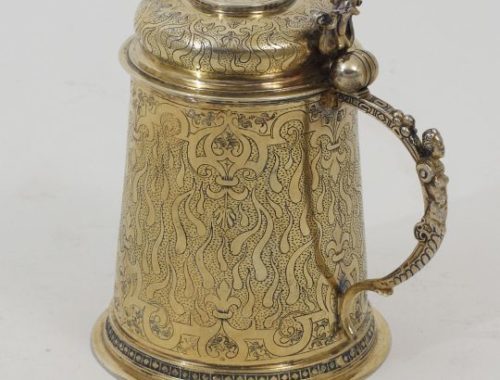Object Number: #115
Brunswick c. 1590
Maker: Hans Pawell II
City’s hallmark: an erected lion, directed heraldically to the right (Spies 1996, Nr. 1)
Maker’s mark: “HP” in round for Hans Pawell II (Spies 1996: I/147)
Engraving: Alliance coat of arms and monograms “IAW” and “AM”.
Height: 15,2 cm (59, 84 in.); weight: 454 gr.
Detailed Information
The finely crafted tankard has the cylindrical shape of a round pitcher. It is raised on a slightly projecting profiled ring base, which is highlighted by a running rhombus-frieze. The wall of the tankard tapers slightly upwards and terminates at a profiled, outwardly curved edge rim. The tankard is almost completely covered with stylised lily ornaments and finely tapered scrolls, while heart shapes form the framework of the teardrop patterned decor. The fine details of rolled leaves, hearts and volute that surround the teardrop pattern make this central decorative element appear quite live due to the punched background. This teardrop décor continues on to the vaulted lid. Centred around teardrops is an elevated and mounted medallion with the engraved alliance coat of arms of two families. Above them the engraved initials “IAW” and “AM”. The two-part, curved ball knob of the tankard has rich ornamental motifs whilst a naked mermaid crowns the spherical thumb rest. The mermaid wears an elaborately braided attire and looks towards the coat of arms. Sea females of this species where at the end of the sixteenth century often used as a crowning of the thumb rest. Above the center of the ball type knob is a feminine herm, which seems to grow from a plant shaped ornament.
Tankards were initially used for liturgical uses and they were later integrated into profane uses, particularly as a vessel for beer. As beer was usually drunk warm, tankards have always had a lid.
Tankards of the present type were common during the late sixteenth century in Germany and England, and were decorated according to the latest fashion. Like other richly decorated silver objects they reflected the wealth of their owners and were often offered as gifts.
The rich décor around the medallion with the coat of arms along with the use of the naked mermaid as well as the use of heart shapes in the decorative motifs of the tankard lead to the assumption that the tankard was most probably a wedding gift.
Coat of arms/Provenance: Coat of Arms on the lid is possibly that of the family von der Wede and family von Marchet.
Maker: Hans Pawell II was born during the last quarter of the sixteenth century. He was a goldsmith, jeweler and stonecutter. In August 1582, he received 130 Thalers from the Duke of Wolfenbüttel for having delivered him with cut stones.





